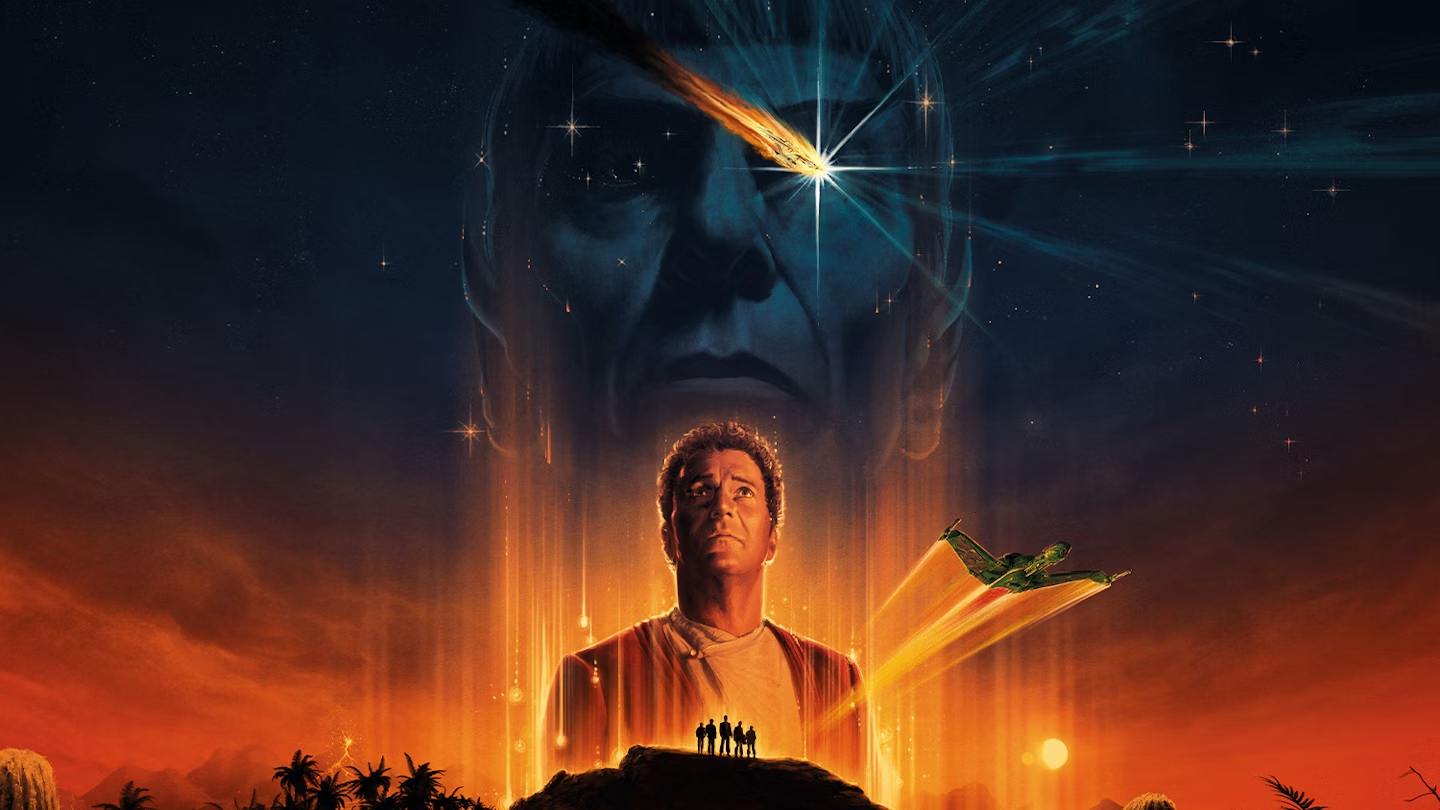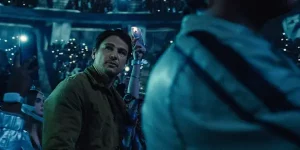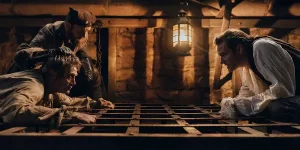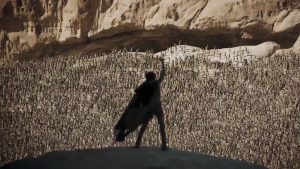
In Simon Pegg’s immortal comedy series Spaced, his character Tim declares: “Every odd-numbered Star Trek movie is shit.” This is, of course, hilarious today, because Pegg was in two odd-numbered Trek films, and even co-wrote the 13th movie, 2016’s Star Trek Beyond. But, the fandom myth of the odd-numbered Star Trek “curse” almost certainly begins with 1984’s Star Trek III: The Search for Spock. Released in movie theaters on June 1, 1984, the third Star Trek feature film was really the second part of what would become a trilogy of films, concluding with The Voyage Home in 1986. But, more than that, The Search for Spock was a pivotal moment in which the more mature aesthetic of Star Trek truly came into its own. Despite the unkind things said about The Search for Spock over the years, the truth is, the movie is perhaps more representative of the franchise as a whole than either of the more well-loved films that precede and follow it.
As The Search for Spock turns 40, here’s why the cohesive world-building of this movie—as directed by Leonard Nimoy—not only works, but impacted the franchise positively forever.
The Search for Spock begins with grainy, diffuse footage from its immediate predecessor; Star Trek II: The Wrath of Khan. Before the titles appear, we relive Spock’s death, and moments from his space burial, as the crew of the Enterprise launched his body in a photon torpedo casket, out into space. This move brilliantly recaps the previous film, but also telegraphs out the stakes of The Search; this movie is about the Star Trek characters, and what they want and need. In short, the prologue and the title of the film promise us something—Spock will be found, because otherwise calling a movie a “search” for Spock would be a weird bummer.
Refreshingly, producer Harve Bennett and Nimoy don’t care about “spoilers” at all. The idea that Spock would be resurrected is basically promised in the title and the simple existence of the movie. If it were a Friends episode it would be called “The One Where Spock Comes Back to Life.” If it were an episode of the 1980s Transformers, it would be called “The Return of Mr. Spock.” You get it.
Even though Nimoy’s name is conspicuously absent from the cast credits, we know he’ll return in this story, which he crafted with Bennett. As Nimoy said at the time, and later, in his 1995 memoir I Am Spock, his primary goal in the movie was to show the Enterprise crew as a family, and give each cast member a moment in the spotlight. “We worked, very consciously, to define special moments for each of the Enterprise bridge crew,” he wrote. Nimoy’s work on Mission: Impossible partially influenced this ensemble structure, because in that series, “each character had a specific job to complete on any given adventure.”
Weirdly, prior to The Search for Spock, this wasn’t really the format of the original Star Trek at all. As much as our cultural memory thinks of Scotty, Uhura, Sulu, and Chekov on equal footing in The Original Series, the truth is that they were really supporting characters, gussied-up guest stars who only later became what we think of as main characters, somewhat after the fact. And arguably, in the two previous films—The Motion Picture and The Wrath of Khan—the crew members who weren’t Kirk, Spock, and Bones had even less to do than before. But The Search for Spock changed all that, and in truly highlighting every single member of the crew—from Sulu’s badass martial arts to Uhura’s hilarious handling of an arrogant young upstart—the film retroactively made us feel like these characters had been correctly showcased all along.
To put it another way, because Spock wasn’t there, the rest of the Star Trek team had more of a chance to shine. As much as this is a Kirk and Bones movie, it’s also a Saavik and David Marcus movie. Robin Curtis was given the thankless task of replacing Kirstie Alley as Saavik, but, arguably, played the character more Vulcan-ish than her predecessor. And because Nimoy was the director of the film, Curtis remains the only actor to play a Vulcan who was cast by the man who basically invented how to play a Vulcan. Does this make Curtis a slightly more canonical Saavik and Alley’s version a bit apocryphal in retrospect? Maybe not. But tie-in media depictions of Saavik, whether in prose or comic book form, tend to favor the Curtis version of the character.
Beyond the character-focused stories that drive the film, The Search for Spock also gave the Star Trek canon a huge makeover. While The Wrath of Khan introduced the new, more naval-inspired “monster maroon” uniforms, The Search for Spock expanded the visual palette of Starfleet significantly. This is the film that expanded the fleet, giving us not just the USS Excelsior and the USS Grissom, but also the iconic Spacedock, designed by Industrial Light and Magic. This Spacedock—which in canon is called Spacedock One—was a major inspiration for Star Trek: Picard season 3 showrunner Terry Matalas. In a recent Search for Spock 40th anniversary magazine interview, Matalas praised the Starfleet designs of Star Trek III, saying, “The Search for Spock is burned into my DNA as the height of what modern Star Trek could be. It was also the height of those ILM miniatures.”
In addition to the new ships and bases for Starfleet, The Search for Spock also gave us the Klingon Bird-of-Prey, not to mention the deadly Klingon dagger, the d’k tahg. While redesigned Klingons had appeared briefly in The Motion Picture, it was in The Search for Spock that Christopher Lloyd as Kruge and John Larroquette as Maltz truly solidified what became the modern conception of Klingons. Yes, Ronald D. Moore would further refine the Klingon culture in The Next Generation, adding the much-needed element of honor, but the dangerous Klingons—the ones you took seriously—began here.
So, with all this wonderful Star Trek goodness, why does The Search for Spock have a less-than-great reputation? Perhaps it’s because the Enterprise was destroyed in this film. Maybe it’s because the movie doesn’t have a true ending, and seems to simply stop. Or maybe it’s because unlike The Wrath of Khan and The Voyage Home, this movie seems more aimed at fans, and less concerned if a mainstream audience can follow what’s going on.
Still, 40 years later, The Search for Spock feels like a blueprint for what modern Star Trek became. It’s a movie that boldly wears its heart on its sleeve, and values the needs of the few—its fans—over the needs of a fickle mainstream public. As the crew steals the Enterprise, Kirk says, “May the wind be out our backs.” After The Search, the Trek franchise would experience good weather, stormy weather, and sometimes, nothing at all. But at this moment, the sailing was smooth, and beautiful.
Star Trek III: The Search for Spock is streaming on Max in the US and Paramount+ in the UK.
The post The Search for Spock Expanded Star Trek Canon in Huge Ways That Changed the Franchise appeared first on Den of Geek.





